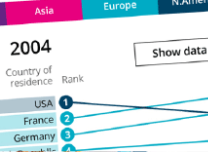Economy UK Trade in goods by classification of product by activity: Jan to Mar 2017 The value of UK imports and exports of goods grouped by product. Goods are attributed to the activity of which they are the principal products. Employment and labour market Labour market economic commentary: June 2017
The UK unemployment rate was 4.6% in the 3 months to April 2017, down from 5.0% a year earlier, and is now at its equal lowest since 1975.
The fall in the unemployment rate relative to a year ago reflects an increase in the employment rate, which remained at a record high of 74.8%.
The number of vacancies remained broadly unchanged in the 3 months to May 2017. Regional labour market statistics in the UK: June 2017
For the 3 months ending April 2017, the highest employment rate in the UK was in the South West (79.1%) and the lowest was in Northern Ireland (68.8%).
For the 3 months ending April 2017, the highest unemployment rate in the UK was in London (6.0%) and the lowest was in the South West (3.4%). Public sector employment, UK: Mar 2017
Total UK public sector employment in March 2017 was 5.424 million, down 7,000 on the previous quarter and 20,000 on the previous year.
Local government employment was down 25,000 at 2.123 million, the lowest since comparable records began in 1999.
Central government employment was up 20,000 on the previous quarter at 2.995 million, the highest since comparable records began in 1999. UK labour market statistics: June 2017
Estimates from the Labour Force Survey show that, between November 2016 to January 2017 and February to April 2017, the number of people in work increased, the number of unemployed people fell, and the number of people aged from 16 to 64 not working and not seeking or available to work (economically inactive) also fell.
There were 31.95 million people in work, 109,000 more than for November 2016 to January 2017 and 372,000 more than for a year earlier.
The employment rate (the proportion of people aged from 16 to 64 who were in work) was 74.8%, the joint highest since comparable records began in 1971. Flat lining productivity is an issue for most developed economies. Since the financial crash of 2008, economists have been left perplexed and disappointed by the absence of any significant revival in productivity growth. But could the 'productivity puzzle' at least partly be explained by the failure of traditional economic measurement techniques to keep pace with the dramatic recent impact of digital technologies? As part of its mission to modernise, develop and improve the UK's economics statistics, ONS is working with leading economists and academic institutions to develop its Economic Statistics Centre of Excellence (ESCoE). Find out more in our latest blogpost and read ONS Fellow Diane Coyle's discussion paper on ESCoE's website: Do-it-yourself digital: the production boundary and the productivity puzzle. | 










No comments:
Post a Comment